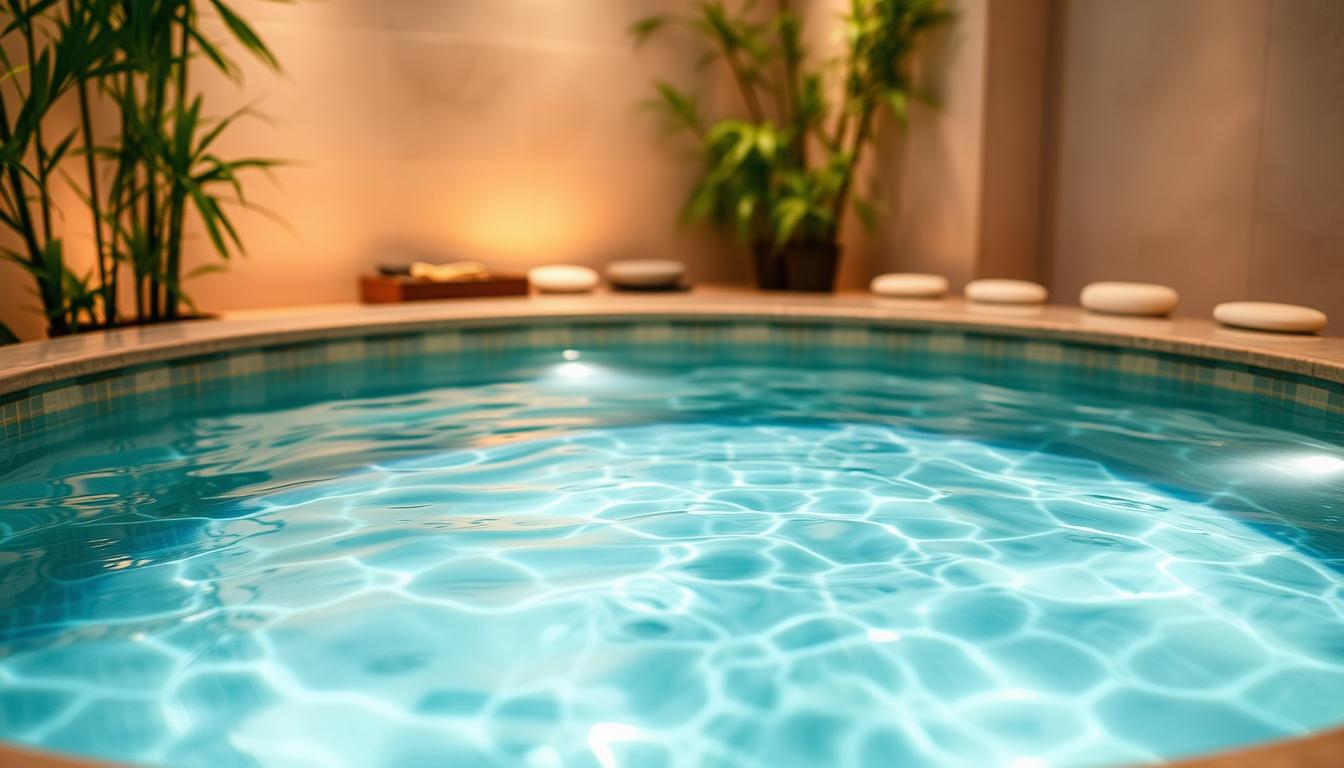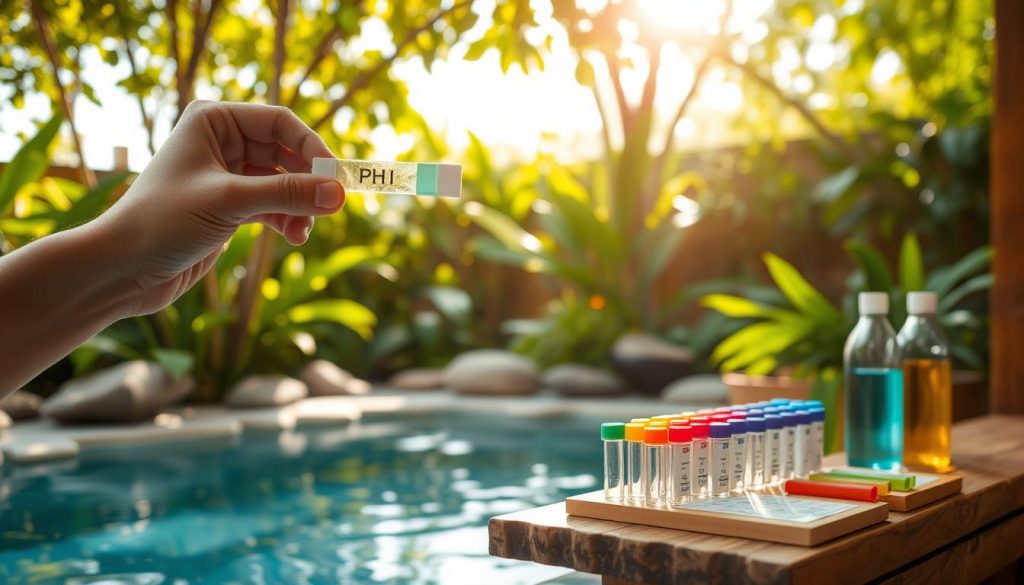
Imagine slipping into your spa after work, only to find murky water. This common issue can ruin your relaxation time. Don’t worry! We’ll help you restore your spa’s water clarity.
With simple maintenance techniques, you can enjoy blissful soaks again. Let’s explore the causes of cloudy spa water and learn how to fix it.
Cloudy spa water can be frustrating, but it’s easy to solve. We’ll cover proper spa water sanitization and effective spa water treatment methods.
This guide will help both new and experienced spa owners. You’ll learn to maintain crystal-clear water for safe and enjoyable spa sessions.
Ready to solve the cloudy water mystery? Grab your test strips and let’s get started!
Understanding Cloudy Spa Water
Cloudy spa water is a common issue for many owners. It affects the spa’s look and raises safety concerns. Let’s explore the causes and safety of using a spa with cloudy water.
What Causes Cloudy Spa Water?
Several factors can make spa water cloudy. Heavy use introduces contaminants like body oils and sweat. Air pollutants, such as dust and pollen, can also contribute.
Poor sanitization leads to bacteria and algae growth. Chemical imbalances and poor filtration cause cloudiness too. Body care products and metals in water are other culprits.
- Heavy usage, which can introduce contaminants like body oils, sweat, and skin cells
- Pollutants in the air, such as dust, pollen, and debris
- Bacteria and algae growth due to poor sanitization or inadequate water circulation
- Chemical imbalances, particularly in pH, alkalinity, and sanitizer levels
- Poor filtration, leading to the accumulation of fine particles and organic matter
- Body care products, such as lotions, hair products, and makeup
- Metals in the water, which can react with sanitizers and cause cloudiness
- Poor water care practices, including infrequent testing and inadequate maintenance
- Air in the system, resulting from leaks or improper priming of the pump
- Poor circulation, which can lead to stagnant water and the buildup of contaminants
To fix cloudy spa water, find the root cause. Test water chemistry, check the filter, and review your maintenance routine. Implement clear spa water tips for best results.
Is It Safe to Use a Spa with Cloudy Water?
Using a spa with cloudy water isn’t recommended. It may contain harmful bacteria that cause skin issues and infections. Cloudy water can also signal chemical imbalances, risking user safety and comfort.
It is essential to rectify the situation and restore clear, properly balanced water before using the spa again. This not only ensures a safe and enjoyable experience but also helps protect the longevity of your spa equipment.
Maintain a clean, safe spa by understanding cloudy water causes. Regular testing and proper maintenance are key. Use spa water cloudiness prevention strategies for crystal-clear water all year.
| Factor | Impact on Spa Water Clarity |
|---|---|
| Heavy usage | Introduces contaminants like body oils, sweat, and skin cells |
| Pollutants in the air | Dust, pollen, and debris can accumulate in the water |
| Bacteria and algae growth | Poor sanitization or inadequate circulation can lead to growth |
| Chemical imbalances | Improper pH, alkalinity, and sanitizer levels can cause cloudiness |
| Poor filtration | Allows the accumulation of fine particles and organic matter |
| Body care products | Lotions, hair products, and makeup can contribute to cloudiness |
| Metals in the water | Can react with sanitizers and cause cloudiness |
| Poor water care practices | Infrequent testing and inadequate maintenance can lead to issues |
| Air in the system | Leaks or improper priming of the pump can introduce air |
| Poor circulation | Stagnant water and the buildup of contaminants can result |
Checking and Balancing Water Chemistry
Proper water chemistry keeps your spa clear and clean. Regular testing of pH, alkalinity, sanitizer levels, and calcium hardness is crucial. These factors contribute to the health of your spa water.

Testing pH Levels and Alkalinity
Test pH and alkalinity levels first. Ideal pH range is 7.2 to 7.8, while total alkalinity should be 80 to 120 ppm. Low levels cause corrosion, high levels lead to scaling and cloudiness.
Use test strips or a digital tester for accurate measurements. Adjust levels with pH increaser or decreaser and alkalinity increaser as needed.
| Parameter | Ideal Range |
|---|---|
| pH | 7.2 – 7.8 |
| Total Alkalinity | 80 – 120 ppm |
Adjusting Sanitizer Levels
Low sanitizer levels can cause cloudy spa water. Keep chlorine at 3 ppm or bromine at 4 ppm. Test regularly and add the right amount to maintain proper levels.
Shock your spa weekly or after heavy use. This eliminates contaminants and keeps water clear.
Proper sanitizer levels are key to preventing cloudy spa water and ensuring a safe, healthy soaking experience.
Addressing High Calcium Hardness
High calcium hardness over 200 ppm can cause scaling and cloudiness. Use a calcium hardness decreaser or partially drain and refill with softer water. Regular testing prevents scale build-up and maintains clear water.
Balance your spa water chemistry to prevent cloudiness. Make these tasks part of your routine for a pristine spa experience.
Clearing Cloudy Spa Water
Is your spa water chemistry off? Time for extra steps. Shocking your spa kills bacteria and removes contaminants. This restores water clarity for a safe, fun experience.
When to Shock Your Spa
Knowing when to shock is key for clear water. Shock your spa after heavy use or parties. Do it when water looks cloudy or smells odd.
Shock if sanitizer levels stay low. Also, shock every 1-2 weeks for maintenance. Always follow product instructions carefully.
Too much shock can harm equipment. Too little won’t fix the issue. Find the right balance for best results.
Using Non-Chlorine Shock Treatments
Non-chlorine shock is great for sensitive skin. It oxidizes non-organic particles without irritation. This option works well for high-use spas.
You can add it with people in the water. It’s also good between regular chlorine shocks.
- After heavy usage, such as a party or extended use by multiple people
- When the water appears cloudy or has an unusual odor
- If the sanitizer levels are consistently low or difficult to maintain
- As part of a regular maintenance schedule, typically every 1-2 weeks
Clarifiers help improve water clarity too. They clump tiny particles for easier filtering. This boosts your spa’s filtration system.
Clean filters every 1-2 months. Replace them every 6-12 months. This depends on use and maker guidelines.
| Cloudy Water Solution | When to Use | Benefits |
|---|---|---|
| Spa Shocking | Heavy usage, unusual odor, low sanitizer levels, every 1-2 weeks | Eliminates bacteria, removes contaminants, restores water clarity |
| Non-Chlorine Shock | Sensitive skin, high usage, between chlorine shocks | Oxidizes non-organic particles, gentle on skin, can be used with people in the water |
| Clarifiers | In conjunction with shocking or as needed | Coagulates tiny particles, enhances filtration effectiveness |
| Filter Cleaning & Replacement | Clean every 1-2 months, replace every 6-12 months | Removes debris, improves filtration, maintains clear water |
By incorporating spa shocking, non-chlorine shock treatments, clarifiers, and regular filter maintenance into your spa care routine, you can effectively combat cloudy water and enjoy a crystal-clear spa experience.
Maintaining Your Spa for Clear Water
Regular spa maintenance prevents cloudy water. Test and adjust water chemistry twice weekly. Keep pH between 7.2-7.5, alkalinity at 80-120 ppm, and sanitizer levels in check.
Clean or backwash filters every few weeks to remove debris. Use a spa cover to minimize airborne contaminants. Ask users to shower before entering and avoid lotions or oils.
Perform a deep clean every 3-4 months. Drain the spa, rinse it thoroughly, and refill with fresh water. This keeps your spa healthy and inviting.
Stick to a regular maintenance schedule to enjoy crystal-clear water. Address issues promptly to avoid cloudy water and health risks. Regular water testing and filter cleaning save time and hassle.







